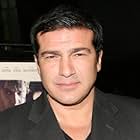IMDb RATING
5.9/10
4.2K
YOUR RATING
Set in 1930s Ukraine, as Stalin advances the ambitions of communists in the Kremlin, young artist Yuri battles to save his lover Natalka from the Holodomor, the death-by-starvation program t... Read allSet in 1930s Ukraine, as Stalin advances the ambitions of communists in the Kremlin, young artist Yuri battles to save his lover Natalka from the Holodomor, the death-by-starvation program that ultimately killed millions of Ukrainians.Set in 1930s Ukraine, as Stalin advances the ambitions of communists in the Kremlin, young artist Yuri battles to save his lover Natalka from the Holodomor, the death-by-starvation program that ultimately killed millions of Ukrainians.
- Awards
- 5 nominations total
Anastasiya Karpenko
- Irena
- (as Anastasia Karpenko)
Storyline
Did you know
- TriviaMax Irons and Aneurrin Barnard played brothers Edward IV and Richard III, respectively in The White Queen (2013)
- SoundtracksWedding March
Music by Anatoliy Mamalyga and Iryna Orlova
Performed by Olha Chornokondratenko (Violin); Vadym Chornokondratenko (Tambourine)
Courtesy of Andamar Entertainment Inc.
Featured review
Everyone knows about the Holocaust but few have even heard the word Holodomor. It means 'death by starvation' and it refers to the Ukrainian mass famine deliberately engineered by Joseph Stalin during 1932-33. Scholars label it as genocide and estimate between 7 and 10 million deaths were directly linked to Stalin's policy of de-populating the Ukraine. More accurate numbers are not available because long-standing Russian secrecy has only recently eased enough for the story to be told. The film Bitter Harvest (2017) is the first feature movie to tell this story using a dramatized romance that attempts to humanise a story of inhumanity.
Set in 1930s Ukraine, the story commences with two young childhood sweethearts in the film's only joyful moments. It quickly moves to Joseph Stalin ordering a mass collectivisation program to confiscate the Ukrainian harvests so he could feed his armies. Most chillingly, he commandeers the grain seeds so famine was not only unavoidable but planned. As their village faces an impending catastrophe, the now grown-up young lovers, aspiring artist Yuri (Max Irons) and his betrothed Natalka (Samantha Barks), must separate as he goes off to join the anti-Bolsheviks in Kiev while she remains to care for her ailing mother. Yuri believes in the power of painting and music to tell the world what is happening but his art teachers in Kiev force him to use art for revolutionary propaganda. As Stalin's forces deplete Ukraine's rural food-stock, villagers are accused of hiding grain and seed and failing to support the revolution. Wherever food is not surrendered there are mass executions in front of mass graves, while others starve to death in their homes and on the streets. Yuri is captured and tortured, but escapes to be re-united with Natalka and they eventually flee to Poland.
The detail of this love story pales against the bigger narrative of Stalinist atrocities. While it is a conventional cinematic device to convey a big story through a small lens, the relationship between the two is critical. The two stories of this film are out of balance and unevenly directed. The attempt to create an epic love story diminishes the magnitude of the Holodomor and almost glosses over the scale of its horrors. While the cinematography is excellent throughout, the acting is wooden, melodramatic, and lacks authenticity. The clean-faced good looks of the dual protagonists form a jarring contrast with the caricatures of the Stalinist scar-faced ogres who are depicted as pure evil. Turning archival images of starved bodies on streets and decimated corpses in mass graves into background props to tell a love story feels disrespectful. The film's lack of nuance and simplicity of narrative is a lost opportunity for insight into this dark episode of history.
It is difficult to be critical of a film that deals with such important subject matter. In terms of the need for the bigger story to be told, this film should be rated highly but as cinema it is seriously flawed. On balance, the one and three-quarter hour investment to see this film is worth the time as it is the only available narrative film of life at the time of the Holodomor. As such, it is educational cinema that helps us understand contemporary Russian-Ukraine politics. However, the shelf-life of this film will be determined only by the time it takes for a better film to be produced.
Set in 1930s Ukraine, the story commences with two young childhood sweethearts in the film's only joyful moments. It quickly moves to Joseph Stalin ordering a mass collectivisation program to confiscate the Ukrainian harvests so he could feed his armies. Most chillingly, he commandeers the grain seeds so famine was not only unavoidable but planned. As their village faces an impending catastrophe, the now grown-up young lovers, aspiring artist Yuri (Max Irons) and his betrothed Natalka (Samantha Barks), must separate as he goes off to join the anti-Bolsheviks in Kiev while she remains to care for her ailing mother. Yuri believes in the power of painting and music to tell the world what is happening but his art teachers in Kiev force him to use art for revolutionary propaganda. As Stalin's forces deplete Ukraine's rural food-stock, villagers are accused of hiding grain and seed and failing to support the revolution. Wherever food is not surrendered there are mass executions in front of mass graves, while others starve to death in their homes and on the streets. Yuri is captured and tortured, but escapes to be re-united with Natalka and they eventually flee to Poland.
The detail of this love story pales against the bigger narrative of Stalinist atrocities. While it is a conventional cinematic device to convey a big story through a small lens, the relationship between the two is critical. The two stories of this film are out of balance and unevenly directed. The attempt to create an epic love story diminishes the magnitude of the Holodomor and almost glosses over the scale of its horrors. While the cinematography is excellent throughout, the acting is wooden, melodramatic, and lacks authenticity. The clean-faced good looks of the dual protagonists form a jarring contrast with the caricatures of the Stalinist scar-faced ogres who are depicted as pure evil. Turning archival images of starved bodies on streets and decimated corpses in mass graves into background props to tell a love story feels disrespectful. The film's lack of nuance and simplicity of narrative is a lost opportunity for insight into this dark episode of history.
It is difficult to be critical of a film that deals with such important subject matter. In terms of the need for the bigger story to be told, this film should be rated highly but as cinema it is seriously flawed. On balance, the one and three-quarter hour investment to see this film is worth the time as it is the only available narrative film of life at the time of the Holodomor. As such, it is educational cinema that helps us understand contemporary Russian-Ukraine politics. However, the shelf-life of this film will be determined only by the time it takes for a better film to be produced.
- CineMuseFilms
- Apr 15, 2017
- Permalink
- How long is Bitter Harvest?Powered by Alexa
Details
Box office
- Budget
- $30,000,000 (estimated)
- Gross US & Canada
- $557,241
- Opening weekend US & Canada
- $219,357
- Feb 26, 2017
- Gross worldwide
- $904,399
- Runtime1 hour 43 minutes
- Color
- Aspect ratio
- 2.35 : 1
Contribute to this page
Suggest an edit or add missing content







































